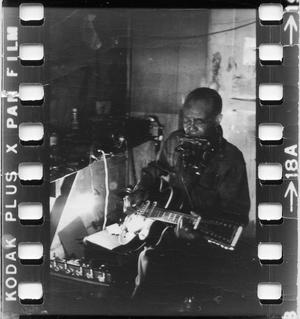Jesse “Lone Cat” Fuller (March 12, 1896 – January 29, 1976) was a Bay Area legend—a blues and folks musician, composer, one-man band, movie extra, tap dancer and general do-it-all kinda guy.
Born in Jonesboro, Georgia, in 1896, Fuller never knew his father, and had lost his mother by age eight. As soon as he felt old enough to make it on his own, Fuller left the deep South in search of a better life. In 1920 he hopped a freight for California, arriving in Los Angeles, where he met Douglas Fairbanks, Sr. and director Raoul Walsh. They got him bit parts in several movies, including “East of Suez”, “Thief of Bagdad” and “Heart of Dixie” and financed a hotdog stand for him.
In 1929, Fuller moved up to Oakland, where he would live for the rest of his life.
Fuller’s music ranged from old work songs, hymns and spirituals to blues, ragtime and pop tunes. His hands were busy playing guitar, so he put together a rack that could hold a harmonica, a kazoo and a microphone, and invented something he called the “fotdella”, a homemade, foot-operated six-string bass that used a modified piano action to drive felt hammers against its strings. This gave his music a solid low end, and he completed the rhythm section with his left foot, keeping time with either a sock cymbal or another homemade contraption that scraped a rubber arm across a washboard.
While things had gone well for him through the 1950s, his career really took off in the 1960s, when he played at increasing numbers of festivals, concerts and coffee houses, delighting audiences all over the US. He created a sensation in England in 1966, playing twice with legendary rock groups The Rolling Stones and the Animals.
His best-known songs include “San Francisco Bay Blues” (covered by Peter, Paul & Mary, Janis Joplin, Hot Tuna, Eric Clapton, and many others) and “Beat It on Down the Line” (covered by the Grateful Dead).
Death and Burial
The Lone Cat died on January 30, 1976 in Oakland, and is buried in Evergreen Cemetery.
By the 1980s, however, most of his recordings were out of print. But now he lives on, thanks to the magic of…
YouTube
- San Francisco Bay Blues
- John Henry/Red River Blues/SF Bay Blues
- Take This Hammer/Walk the Line(?)/Runnin’ Wild/Hi, Sheriff
Links and References
- Jesse Fuller at Find A Grave
- Jesse Fuller at Wikipedia
- Fuller (Jesse) Collection at African American Museum and Library at Oakland
- MS193_B01_027 African American Museum and Library at Oakland




